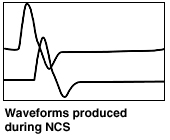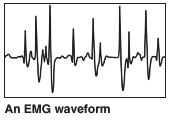NCS and EMG Tests
Nerve conduction study (NCS) and electromyography (EMG) are tests that measure muscle and nerve function. In most cases, both tests are done. NCS is most often done first. You will be asked to lie on an exam table with a blanket over you.
Nerve conduction study (NCS)

During NCS, mild electrical currents are used to test how fast electrical signals move along your nerves. Small metal disks (electrodes) will be attached to your skin on the part of your body being tested. This will be done using water-based gel or paste. A healthcare provider or technologist will apply mild electrical currents to your skin. Your muscles will twitch, but the test won’t harm you. Currents are usually applied to the same area several times. Usually, the strength of the electrical current is increased on each body part. You may have some increasing mild pain. This varies from person to person. But the electrical current is not dangerous. The testing may continue on other parts of your body unless only 1 part of your body needs to be tested.
Electromyography (EMG)

Most of the electrodes will be removed for EMG. The healthcare provider will use alcohol to clean your skin in the area to be tested. A very thin sterile needle will be inserted into the muscles in this area. When the needle is inserted, you may feel as if your skin is being pinched. You will be asked to relax and contract the muscle being tested. Following directions will let your provider interpret the test results.
During each test, wavy lines (waveforms) appear on a screen or on paper. These lines show how well your nerves and muscles work. These waveforms help to determine your test results.
Before the tests
Prepare for your tests as directed. Shower or bathe, but don't use powder, oil, or lotion. Your skin should be clean and free of excess oil. Wear loose clothes. You may be asked to change into a hospital gown. The entire test will take about 60 minutes. Allow extra time to check in.
Important
For your safety and for the success of your test, tell the technologist if you:
-
Have any bleeding problems
-
Take blood thinners (anticoagulants) or other medicines, including aspirin
-
Have any immune system problems
-
Have had neck or back surgery
-
Have implantable devices, such as spinal cord or brain stimulator, pacemaker, or defibrillator
You may also be asked questions about your overall health.
After the tests
Before you leave, all electrodes will be removed. You can then get right back to your normal routine. If you feel tired or have some mild pain, take it easy. If you were told to stop taking any medicines for your test, ask when you can start taking them again. Your healthcare provider will let you know when your test results are ready.
Online Medical Reviewer:
Anne Fetterman RN BSN
Online Medical Reviewer:
Luc Jasmin MD
Online Medical Reviewer:
Raymond Kent Turley BSN MSN RN
Date Last Reviewed:
8/1/2022
© 2000-2024 The StayWell Company, LLC. All rights reserved. This information is not intended as a substitute for professional medical care. Always follow your healthcare professional's instructions.